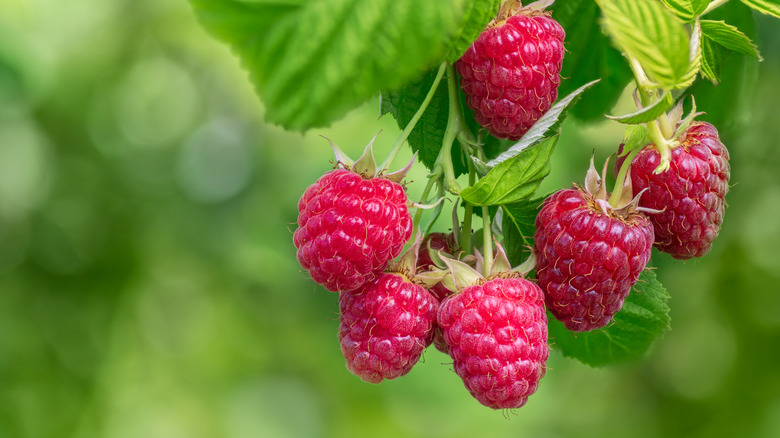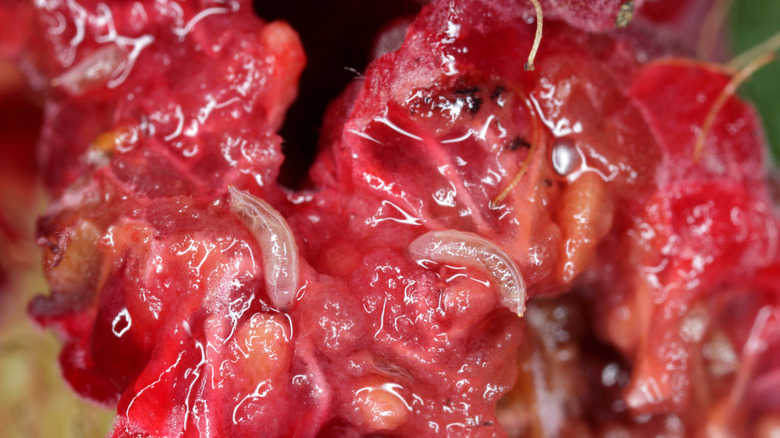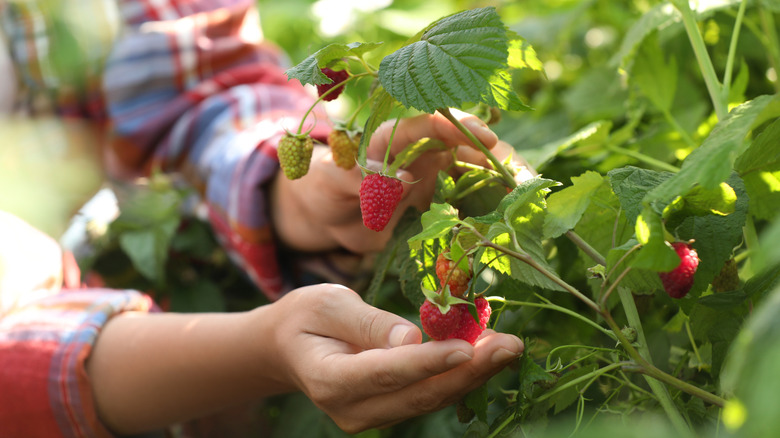The Common Garden Pest That Is Hiding In Your Raspberries
For commercial and home gardeners alike, raspberry season is in full effect. This means there are plenty of opportunities to turn your juicy raspberry harvests into jams, lemonades, cakes and more. Depending on the specific raspberry variety you have in your garden, the plant will typically bear fruit either during the summer (ripening in late June or July) or fall (ripening in August or September). Growing your own raspberries has many advantages — who wouldn't enjoy an endless supply of these sweet treats? However, there is one major pest that raspberry growers must contend with if they want to yield bountiful and healthy harvests.
At first glance, the spotted wing drosophila (SWD) could be mistaken for common fruit flies. Measuring 2 to 3 millimeters long in its adult form, this small but mighty menace has been disrupting crops and frustrating gardeners for decades now since it was first discovered in the United States in 2008. And though it belongs to the fruit fly genus, Drosophila, there is one critical difference that sets the SWD insects apart from similar flies. The common drosophila only seeks out rotting or damaged fruit that has fallen off the tree or bush. SWD, on the other hand, feeds on healthy fruit that is still maturing.
Attracted to soft produce with a delicate outer layer, SWD prefers raspberries, especially those varieties that ripen in August and September. The flies have also been found in other cane berries, like blackberries and strawberries, as well as ripe grapes. Because of this, it's incredibly important to monitor the presence of these pests in your berry garden through traps and other methods in order to avoid the havoc caused by their feeding and breeding habits.
What are spotted wing drosophilas?
In order to grasp why SWDs are so destructive to raspberry crops, it's crucial to understand their life cycle from eggs to larvae to adults. Native to Southeast Asia, these insects have been observed in most regions of the U.S. as well as Europe and South America. During raspberry season, as the fruit begins to ripen, female flies will attack the surface with her ovipositor, or egg-laying apparatus, a saw-like organ that punctures the flesh of the fruit.
From there, the SWD will lay around one to three eggs in each sting, averaging around 16 eggs daily for a month. Once implanted inside the skin of the fruit, larvae will hatch from the eggs between 12 to 72 hours and begin their feeding period. Headless and legless, these cream-colored maggots will reach maturity around a week or less, where they will choose to pupate in the infected fruit or abandon it to continue the pupal stage elsewhere. Within 15 days, the adult fly will form, wherein the process will begin again.
As the tiny larvae nibble from the inside and get bigger, the raspberry will become wrinkly and mushy at the feeding site, eventually caving in. This is one of the first indications of a SWD infection. Other tell-tale signs include brown spots, molding, and excessive liquid. Their presence can also introduce and accelerate other issues like fungal disease, attacks from other insects, and bacteria. For instance, while using her ovipositor, a female SWD may expose raspberries to Acetobacter, which causes decomposition.
How to monitor and prevent SWDs
Within their short lives, female SWDs can lay up to 350 eggs. And because the larvae feed inside the fruit, growers usually do not notice the problem until harvest time. For these reasons, it's important to get a handle on the insects if you suspect infestation — it's very easy for their populations to explode to unmanageable numbers. As your raspberries grow, make sure to check your fruit daily, inspecting for signs of unusual softness and juice leakage. If you find any infected fruit, remove it from the bush immediately, and store it in a clear plastic bag. You can either bury the bag or place it in full sunlight to kill the larvae. If you compost and/or throw away the fruit without sealing it, the larvae will be able to crawl out and find a new location. You can also do a salt water test — if you submerge infected berries in salt water, the larvae will bob to the top.
If you wish to protect your berry patch from SWDs, frequent pruning and proper watering methods are key preventative measures, since adult flies seek out humid and shaded spaces to live. Growers can also make DIY bug traps using apple cider vinegar as a way of luring adults. Be aware, though, that these traps are best for figuring out whether SWDs are present, and do not do much in the way of decreasing their numbers. Other tips include covering your patch with mesh netting and harvesting as soon as your berries change color. Be sure to clear the ground of fallen fruit that is overripe or decaying, as adult SWDs will flock to it for shelter.


